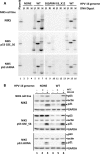Papillomavirus E6 PDZ interactions can be replaced by repression of p53 to promote episomal human papillomavirus genome maintenance
- PMID: 24352452
- PMCID: PMC3958089
- DOI: 10.1128/JVI.02360-13
Papillomavirus E6 PDZ interactions can be replaced by repression of p53 to promote episomal human papillomavirus genome maintenance
Abstract
Cancer-associated human papillomaviruses (HPVs) express E6 oncoproteins that target the degradation of p53 and have a carboxy-terminal PDZ ligand that is required for stable episomal maintenance of the HPV genome. We find that the E6 PDZ ligand can be deleted and the HPV genome stably maintained if cellular p53 is inactivated. This indicates that the E6-PDZ interaction promotes HPV genome maintenance at least in part by neutralization of an activity that can arise from residual undegraded p53.
Figures

Similar articles
-
Targeting the Two Oncogenic Functional Sites of the HPV E6 Oncoprotein with a High-Affinity Bivalent Ligand.Angew Chem Int Ed Engl. 2015 Jun 26;54(27):7958-62. doi: 10.1002/anie.201502646. Epub 2015 May 27. Angew Chem Int Ed Engl. 2015. PMID: 26014966 Free PMC article.
-
Stabilization of HPV16 E6 protein by PDZ proteins, and potential implications for genome maintenance.Virology. 2011 Jun 5;414(2):137-45. doi: 10.1016/j.virol.2011.03.017. Epub 2011 Apr 13. Virology. 2011. PMID: 21489588
-
PDZ Domain-Containing Protein NHERF-2 Is a Novel Target of Human Papillomavirus 16 (HPV-16) and HPV-18.J Virol. 2019 Dec 12;94(1):e00663-19. doi: 10.1128/JVI.00663-19. Print 2019 Dec 12. J Virol. 2019. PMID: 31597772 Free PMC article.
-
Interactions of human papillomavirus transforming proteins with the products of tumor suppressor genes.FASEB J. 1993 Jul;7(10):872-9. doi: 10.1096/fasebj.7.10.8393818. FASEB J. 1993. PMID: 8393818 Review.
-
The role of the E6-p53 interaction in the molecular pathogenesis of HPV.Oncogene. 1999 Dec 13;18(53):7690-700. doi: 10.1038/sj.onc.1202953. Oncogene. 1999. PMID: 10618709 Review.
Cited by
-
Persistent Human Papillomavirus Infection.Viruses. 2021 Feb 20;13(2):321. doi: 10.3390/v13020321. Viruses. 2021. PMID: 33672465 Free PMC article. Review.
-
Targeting PDZ domains as potential treatment for viral infections, neurodegeneration and cancer.Biol Direct. 2021 Oct 12;16(1):15. doi: 10.1186/s13062-021-00303-9. Biol Direct. 2021. PMID: 34641953 Free PMC article. Review.
-
Cancer-causing human papillomavirus E6 proteins display major differences in the phospho-regulation of their PDZ interactions.J Virol. 2015 Feb;89(3):1579-86. doi: 10.1128/JVI.01961-14. Epub 2014 Nov 19. J Virol. 2015. PMID: 25410862 Free PMC article.
-
Viral Interactions with PDZ Domain-Containing Proteins-An Oncogenic Trait?Pathogens. 2016 Jan 18;5(1):8. doi: 10.3390/pathogens5010008. Pathogens. 2016. PMID: 26797638 Free PMC article. Review.
-
Degradation of Human PDZ-Proteins by Human Alphapapillomaviruses Represents an Evolutionary Adaptation to a Novel Cellular Niche.PLoS Pathog. 2015 Jun 18;11(6):e1004980. doi: 10.1371/journal.ppat.1004980. eCollection 2015 Jun. PLoS Pathog. 2015. PMID: 26086730 Free PMC article.
References
Publication types
MeSH terms
Substances
Grants and funding
LinkOut - more resources
Full Text Sources
Other Literature Sources
Research Materials
Miscellaneous

